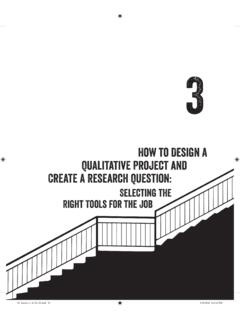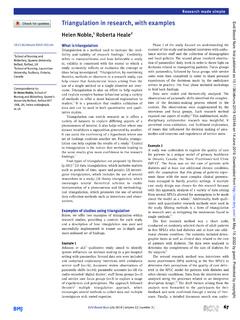Transcription of CHOOSING A MIXED METHODS DESIGN - SAGE Publications …
1 58 CHAPTER4 CHOOSING A MIXEDMETHODS DESIGNR esearch designs are procedures for collecting, analyzing, interpreting,and reporting data in research studies. They represent different mod-els for doing research, and these models have distinct names andprocedures associated with them. Rigorous research designs are importantbecause they guide the METHODS decisions that researchers must make dur-ing their studies and set the logic by which they make interpretations at theend of studies. Once a researcher has selected a MIXED METHODS approach fora study, the next step is to decide on the specific DESIGN that best addressesthe research problem. What designs are available, and how do researchersdecide which one is appropriate for their studies?
2 MIXED METHODS researchersneed to be acquainted with the major types of MIXED METHODS designs andthe common variants among these designs. Important considerations whenchoosing designs are knowing the intent, the procedures, and the strengthsand challenges associated with each DESIGN . Researchers also need to befamiliar with the timing, weighting, and mixing decisions that are made ineach of the different MIXED METHODS chapter will address The classifications of designs in the literature The four major types of MIXED METHODS designs, including theirintent, key procedures, common variants, and inherent strengths andchallenges04-Creswell (Designing) 5/16/2006 8.
3 35 PM Page 58 Factors such as timing, weighting, and mixing, which influence thechoice of an appropriate designCLASSIFICATIONS OF MIXED METHODS DESIGNS Researchers benefit from being familiar with the numerous classifications ofmixed METHODS designs found in the literature. These classifications repre-sent different disciplines, and they use different terminology. Researchersshould be aware of the range of MIXED METHODS DESIGN types, as well as thediscipline-based discussions of MIXED METHODS writing about MIXED METHODS research have devoted agreat deal of attention to classifying the different types of MIXED methodsdesigns. In the final chapter of the Handbook of MIXED METHODS in Socialand Behavioral Research,Tashakkori and Teddlie (2003b) noted that theyhad found nearly 40 different types of MIXED METHODS designs in the litera-ture.
4 Creswell, Plano Clark, et al. (2003) have summarized the range of theseclassifications. Their summary has been updated, and a list of 12 classifica-tions is included in Table These classifications represent diverse socialscience disciplines, including evaluation, health research, and educationalresearch, which span the past 15 years of scholarly writings about mixedmethods approaches. The different types and various classifications speak tothe evolving nature of MIXED METHODS the long list of DESIGN types in Table may be is easy to get lost in the details, as these classifications are drawn fromdifferent disciplines, have emphasized different facets of MIXED methodsdesigns, and lack consistency in the names of the designs.
5 It may evenappear that little agreement exists among these authors and that there arean infinite number of DESIGN options. In fact, although authors have empha-sized different features and used different names, there are actually moresimilarities than differences among these classifications. Based on thesesimilarities, we feel that a parsimonious and functional classification can becreated. Thus we advance four major MIXED METHODS designs, with variantswithin each FOUR MAJOR TYPES OF MIXED METHODS DESIGNS The four major types of MIXED METHODS designs are the Triangulation DESIGN ,the Embedded DESIGN , the Explanatory DESIGN , and the Exploratory following sections provide an overview of each of these designs: theiruse, procedures, common variants, and a MIXED METHODS DESIGN 5904-Creswell (Designing) 5/16/2006 8.
6 35 PM Page 59 AuthorGreene, Caracelli,and Graham(1989)Patton (1990)Morse (1991)Steckler, McLeroy,Goodman, Bird,and McCormick(1992)Greene andCaracelli (1997)60 DESIGNING AND CONDUCTING MIXED METHODS RESEARCHD isciplineEvaluationEvaluationNursingPubl ic health educationEvaluationMixed Method DesignsInitiationExpansionDevelopmentCom plementaryTriangulationExperimental DESIGN , qualitative data, andcontent analysisExperimental DESIGN , qualitative data, andstatistical analysisNaturalistic inquiry, qualitative data, andstatistical analysisNaturalistic inquiry, quantitative data, andstatistical analysisSimultaneous triangulationQUAL + quanQUAN + qualSequential triangulationQUAL quanQUAN qualModel 1: Qualitative METHODS to developquantitative measuresModel 2: Qualitative METHODS to explainquantitative findingsModel 3.
7 Quantitative METHODS to embellishqualitative findingsModel 4: Qualitative and quantitativemethods used equally and parallelComponent designsTriangulationComplementaryExpansi onIntegrated designsIterativeEmbedded or nestedHolisticTransformativeTable Method DESIGN Classifications04-Creswell (Designing) 5/16/2006 8:35 PM Page 60 CHOOSING a MIXED METHODS DESIGN 61 DisciplineHealth researchEducational researchEducational policyNursingEducational researchMixed Method DesignsComplementary designsQualitative preliminaryQuantitative preliminaryQualitative follow-upQuantitative follow-upMixed method designsEquivalent status (sequential or parallel)Dominant less dominant (sequential orparallel)Multilevel useMixed model designs:I.
8 Confirmatory, qualitative data,statistical analysis, and inferenceII. Confirmatory, qualitative data,qualitative analysis, and inferenceIII. Exploratory, quantitative data,statistical analysis, and inferenceIV. Exploratory, qualitative data,statistical analysis, and inferenceV. Confirmatory, quantitative data,qualitative analysis, and inferenceVI. Exploratory, quantitative data,qualitative analysis, and inferenceVII. Parallel MIXED modelVIII. Sequential MIXED modelConvergence modelSequential modelInstrument-building modelSequentialConcurrentIterativeSandwi chSequential explanatorySequential exploratorySequential transformativeConcurrent triangulationConcurrent nestedConcurrent transformativeAuthorMorgan (1998)Tashakkori andTeddlie (1998)Creswell (1999)Sandelowski(2000)Creswell, PlanoClark, Gutmann,and Hanson(2003)(Continued)04-Creswell (Designing) 5/16/2006 8:35 PM Page 61 The Triangulation DesignThe most common and well-known approach to mixing METHODS is theTriangulation DESIGN (Figure ) (Creswell, Plano Clark, et al.)
9 , 2003). The pur-pose of this DESIGN is to obtain different but complementary data on the sametopic (Morse, 1991, p. 122) to best understand the research problem. The intentin using this DESIGN is to bring together the differing strengths and nonoverlap-ping weaknesses of quantitative METHODS (large sample size, trends, generaliza-tion) with those of qualitative METHODS (small N, details, in depth) (Patton, 1990).This DESIGN and its underlying purpose of converging different METHODS hasbeen discussed extensively in the literature ( , Jick, 1979; Brewer & Hunter,1989; Greene et al., 1989; Morse, 1991). This DESIGN is used when a researcherwants to directly compare and contrast quantitative statistical results with quali- tative findings or to validate or expand quantitative results with qualitative DESIGN Triangulation DESIGN is a one-phasedesign in which researchers implement the quantitative and qualitative62 DESIGNING AND CONDUCTING MIXED METHODS RESEARCHD isciplinePrimary medical careSocial and behavioralresearchMixed Method DesignsInstrument DESIGN modelTriangulation DESIGN modelData transformation DESIGN modelMultistrand designsConcurrent MIXED designsConcurrent MIXED method designConcurrent MIXED model designSequential MIXED designsSequential MIXED
10 Method designSequential MIXED model designMultistrand conversion MIXED designsMultistrand conversion MIXED method designMultistrand conversion MIXED model designFully integrated MIXED model designAuthorCreswell, Fetters,and Ivankova(2004)Tashakkori andTeddlie (2003b)Table (Continued)SOURCE: Adapted from Creswell, Plano Clark, et al. (2003, pp. 216-217, Table ).04-Creswell (Designing) 5/16/2006 8:35 PM Page 62 CHOOSING a MIXED METHODS DESIGN 63(a) Triangulation DESIGN (c) Triangulation DESIGN : Data Transformation Model (Transforming QUAL data into QUAN) Interpretation based onQUAN + QUAL resultsQUANQUAL(b) Triangulation DESIGN : Convergence Model QUAN resultsQUAL resultsQUAN dataanalysisQUAL dataanalysisQUAN datacollectionQUAL datacollectionCompareandcontrastInterpre tationQUAN + QUALT ransformQUAL intoquan dataQUAN data analysisQUAL dataanalysisQUAN datacollectionQUAL datacollectionInterpretationQUAN + QUALC ompare andinterrelate twoQUAN data setsQUAN resultsqualresultsQUAN dataanalysisqualdataanalysisQUAN datacollection.












